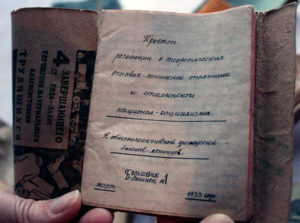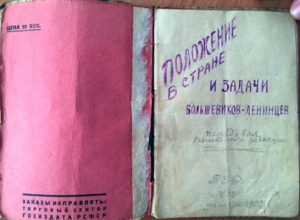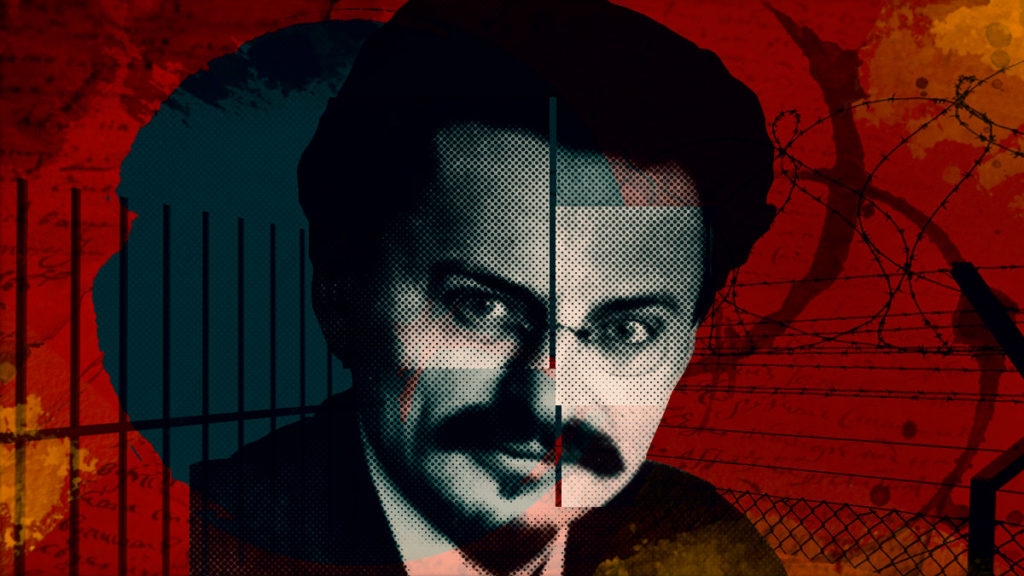NOTE: This is the first of three linked documents on Left Oppositionists in a Russian Prison. The brief introductory reading guide is here. An academic article explaining the origin of the prison text is here. The final document — the text from the imprisoned Left Oppositionists in the 1930s — is here.
This year is a unique one, crushed by the pandemic and crisis sweeping the world, with the capitalist social order shaken and beginning to be challenged both in the consciousness and through the actions of many workers and oppressed sectors across the planet. It is also the eightieth anniversary of the assassination of the Russian revolutionary Leon Trotsky, murdered in Mexico by an agent of Stalin.
Trotsky was the founder of the only revolutionary socialist current that survived what political activist Victor Serge called “midnight in the century” in his 1939 novel1Victor Serge, Midnight in the Century (New York: NYRB Classics, 2014. — the combined counterrevolution of Stalinism, fascism, and “democratic” imperialists. Thanks to Trotskyism’s struggle at a crucial moment in history, the ideas of revolutionary Marxism are still alive, as are the militant currents that persist today in the struggle for a society without exploitation and oppression. The times ahead will be critical, and the alternative of “socialism or barbarism” will once again be posed in the decades to come — hence the fundamental importance of knowing the history of those past struggles.
For a good part of the twentieth century, Stalinism used the word “communism” with the pretense of identifying it with the parasitic bureaucratic dictatorships of the workers’ states. But that is not communism. No, communism is the struggle for achieving a society without a state and without social classes, free of exploitation and all oppression. The Trotskyist Left Opposition fought for this perspective against Stalinism in the Soviet Union and internationally.
Today we present a dossier on the discovery of a set of documents belonging to the Trotskyist Left Opposition in the Soviet Union in the 1930s, comprising 30 notebooks found by chance in early 2018 during the refurbishment of a prison in Verkhneuralsk, a town in the Chelyabinsk Oblast in southern Russia at the foot of the Ural Mountains. During the Stalinist regime, the prison operated as part of what is now known to history as the “Gulag,”2ГУЛаг, Главное Управление Лагерей, “General Administration of the Camps” — the name of the government agency that ran them. a concentration camp system used to terrorize the entire population and persecute political opponents. Russian historian Vadim Rogovin (1937–1998) wrote that after the dissolution of the Soviet Union and the opening of the KGB’s archives, it could be established that during the period of Stalin’s government, some 4 million people passed through these camps and political prisons (half of them in 1937–38 alone), and of those, between 700,000 and 800,000 were shot (the great majority in those same two years).

Aleksandr Fokin, a researcher leading the study of the booklets, translated the two texts from Russian and also presented his work in a 2018 academic paper published by Ural Federal University in Yekaterinburg, Russia. In it, he discussed the research project and his study of the history of the Soviet Left Opposition. He also has a second article that includes the full text of one of the booklets, transcribed by Fokin and with a small introduction by him.
The discovery of these booklets, as Fokin says, allows us to delve deeper into the history of the Soviet Left Opposition — a topic that was completely forbidden before the collapse of the Soviet Union. Afterwards, only a small handful of researchers in Russia took it up: for example, Aleksei Gusev, Shabalin, and Vakulenko, whose works, as far as we know, were published only in Russian. And there was the aforementioned Vadim Rogovin, a sympathizer of Trotskyism who between 1992 and 1998 published his work Was There an Alternative? — a monumental history of the Stalinist era and Soviet Trotskyism in six volumes (plus a small introductory volume) covering the years between 1923 and 1940, which he intended to complete with a seventh volume covering the period of World War II. His early death prevented him from completing the project. His work was published in its entirety in Russian, and translated into German, with only a few volumes in English, which are now out of print.3SMC translator’s note: At present, there is only a small selection of two essays from Rogovin’s work available in English. See Vadim Z. Rogovin, Was there an alternative to Stalinism in the USSR? (Oak Park, MI: Mehring Books, 2003). Only a few historians in the West, such as Pierre Broué and Jean-Jacques Marie, have researched this topic.
What was the aim of all this terror, in a state that spoke for socialism but itself exterminated the vast majority of the leaders of the October Revolution and the Communist International? Here, we will try to provide some context for understanding the texts we’re publishing.
The Trotskyist Left Opposition emerged in 1923 as an internal tendency within the Communist Party (Bolshevik) of the Soviet Union, to confront the bureaucracy that had sprung up in the leadership of both the party and the state when Lenin withdrew from active participation because of his health problems and then his death in January 1924. The origins of the dispute can be traced back to the discussions around the New Economic Policy (NEP) and the relationship between the proletariat and the peasantry, as well as between industry and the countryside. The NEP was introduced in 1921 at Lenin’s behest as a sort of tactical “retreat” in which the Bolsheviks in power agreed to a series of concessions to the peasantry by reinstituting certain market mechanisms aimed at mitigating the disastrous effects on the economy caused by four years of civil war. The objective was to keep the peasantry from siding with the capitalist counterrevolution and to maintain an alliance with the working class and the Soviet workers’ state.
The Bolsheviks did not naïvely think that applying this or that economic policy was a way to develop an isolated socialist society within Russia’s borders. They knew such an idea was completely utopian in one of the most backward countries of Europe (and Asia). From the beginning, they saw themselves simply as the Russian detachment of a great general staff of the world socialist revolution, for which the triumph of the revolution in Russia was only one toehold. The greatest factor pushing this relative retrenchment, this idea of putting the Soviet Union in the best sort of “holding pattern” while it waited for the Communist International to be able to take advantage of new revolutionary uprisings in the world to defeat imperialism, was the defeat of the revolution in the West, especially the setback suffered by the German revolution in October 1923.
On the domestic level, the concessions to the market were to be counterbalanced and controlled by strengthening workers’ power, by maintaining the economic reins in their hands through the state monopoly of foreign trade, banking, and industry, and by restricting the exercise of political rights to those laborers — that is, by upholding the character of the political regime as a dictatorship of the proletariat. But the industrial working class had emerged from the civil war decimated and deeply weakened — especially its vanguard, centered in the Bolshevik Party, which had fought on the front lines against the White armies. It is in this context that the rise of bureaucratic elements to the leadership of the Bolshevik Party took place. They detached themselves from the working class base in the factories, while exhaustion and apathy won over the soviets, which began to transform themselves from an expression of workers’ democracy into instruments of the bureaucracy — ultimately developing a conservative mentality.

In some theses unpublished at the time, Trotsky describes the origin of this mentality:
Revolution is impossible without the participation of the masses. This participation is in its turn possible only when the oppressed masses connect their hopes for a better future with the idea of revolution. In a sense the hopes engendered by the revolution are always exaggerated. … But from these same conditions comes one of the most important — and moreover, one of the most common — elements of the counterrevolution. The conquests gained in the struggle do not correspond, and in the nature of things cannot directly correspond, with the expectations of the broad backward masses awakened for the first time in the course of the revolution. The disillusionment of these masses, their return to routine and futility, is as much an integral part of the post-revolutionary period as is the passage into the camp of “law and order” of those “satisfied” classes or layers of classes that had participated in the revolution. … These are the moods which bureaucratism — as an element of “law and order” and “tranquility” — banks on. The attempt of the opposition to pose new questions before the party ran up against precisely these moods.4Leon Trotsky, “Theses on Revolution and Counterrevolution” (1926).
The ideological expression of this conservatism was the “theory” invented by Stalin in 1924 known as “socialism in one country,” according to which all the elements in Soviet Russia were given over to building an isolated socialist society (what the Verkhneuralsk notebook reprinted in the linked article refers to as “national socialism”), abstracted from international issues and relegated to the Communist Parties of the capitalist countries. In the beginning, this conception was not yet theoretically incompatible with promoting revolution in the capitalist countries, but the form Stalinism’s orientation took culminated in terrible disasters, the most notorious being the defeats of the second Chinese Revolution of 1925–27 and the 1926 British general strike. As this spiral of defeats left the Soviet Union increasingly isolated and in a desperate situation, the Stalinist bureaucracy itself was consolidating. As early as the Sixth Congress of the Communist International (1928), it became clear that the defense of the Soviet Union was a greater priority than revolutions in the rest of the world. Then, beginning in the mid-1930s and against the backdrop of the orientation of the Seventh Congress of the Communist International, the experience of the Spanish revolution, and a wave of factory occupation, both in 1936, it became clear that pure self-preservation of the Soviet bureaucracy, to the exclusion of all else, had assumed an openly counterrevolutionary role — as was seen later in Italy, France, and Greece after World War II.
At the beginning of the bureaucratization, in the Soviet Union’s countryside, Stalin’s bureaucratic clique went in the opposite direction of the Bolshevik Party’s original formulation of the NEP and deepened all of its most dangerous aspects. It gave more and more concessions to the peasants, especially to its richest sector — called the kulaks — to the detriment of the social and economic power of the working class. The justification was the “link” (smychka) between the working class and the peasantry, which led to the paradoxical situation in which the working class — which in theory should be the hegemonic class of Soviet society — found itself in an increasingly unfavorable position vis-à-vis the “hegemonized” peasantry.
The only analogy the Bolsheviks could draw on to analyze the sociology of their own triumphant revolution was the French Revolution at the end of the 18th century. Thus, the Left Opposition began to consider the possibility that the strength of the kulaks and pro-capitalist elements could lead to a counterrevolution that would dislodge the revolutionaries and the working class from power — a comparison with the so-called “Thermidor” in the French Revolution. Thermidor was the coup d’état of July 27, 1794 that overthrew the Jacobin revolutionaries and their social base, the plebeian social sectors known as the sans-culottes, which took the French Republic on a conservative course that some years later would be consecrated with the rise to power of Bonapartism. At first, Trotsky and the Left Opposition saw this danger embodied in an eventual triumph of openly restorationist forces — that is, a return to capitalism — supported by the peasant base. But in the 1930s, Trotsky corrected this view and reasoned that a more correct appreciation of Thermidor was to consider it a reaction against the very social basis of the revolution, something that he had concluded was no longer a possibility in the future but an already accomplished fact. He traced this to the Stalinist bureaucracy’s successful expropriation of power from the working class in the soviets beginning in 1923–24 without returning to capitalism (compare the 1926 “Theses on Revolution and Counterrevolution” cited earlier with Trotsky’s “The Workers State, Thermidor and Bonapartism” of 1935). The Stalinist regime was not only a “Thermidor and Bonapartism” in 1935, but with the very “Bonapartist” turn of Stalinism, it was fertilizing the ground for capitalist restoration by means of a social counterrevolution that would even end up sweeping away the bureaucracy itself.5SMC translator’s note: The term “Bonapartism,” from Karl Marx’s 1852 work The Eighteenth Brumaire of Louis Bonaparte, refers to the emergence of an authoritarian leader when different sectors of social classes are struggling against each other and are unable to find a way to impose representatives from their own ranks. In this context, a “Bonaparte” emerges who presents himself as an arbiter from above, separate from the dominant class and somehow not beholden to any of its institutions. A Bonapartist leader often leans on the military and seeks to give the executive branch of government more autonomy from other branches.
The bureaucracy had been transformed into a social stratum with its own interests — interests opposed to those of the working class and different from the other classes and sectors of class in Soviet society — while at the same time, and in contradiction, the bureaucracy’s very social foundation was the property relations established by the October Revolution. It was not a kind of “bureaucratic bourgeoisie” in the framework of some sort of “state capitalism,” which different Left currents of the time suggested (a view many of them maintain to this day), since the very concept of capitalism based on an economy in which the capitalists had been completely or mostly expropriated, along with the state monopoly of foreign trade, banking, and industry and along with economic planning (even if that was increasingly bureaucratic) was a contradiction in terms. The bureaucracy’s domination as a social stratum was based on the administration of this nationalized property, without really owning the property, which gave its dominance a highly unstable character. The growing terror imposed by Stalinism — which between 1936 and 1939, at the height of the Moscow trials, would reach the level of mass executions and concentration camps — was not a sign of its strength, but a clear demonstration of the fragility of its rule, which required extremely disruptive measures to resolve. The bureaucracy’s tendency towards Bonapartism reflected its intermediate and oscillating position between the Soviet working class and world imperialism, in the absence of a native Russian capitalist class.
Until the Sixth Congress of the Communist International (1928), the fight of the Left Opposition was to strengthen the working class within the Soviet Union socially and politically against the weight of the peasants and to fight against bureaucracy and for the democratization of the party and the soviets. But the bureaucracy’s policy, in line with its position in the middle, was characterized by sharp zigzags to the right and the left.
In 1928, confronted with the growth and self-confidence of the kulaks and the pro-capitalist tendencies in the countryside, the bureaucracy saw its existence threatened “from the right.” That was the year the grain crisis broke out.6SMC translator’s note: This is sometimes referred to as “the crisis of the NEP.” At the beginning of January, the kulaks sought an increase in the price of grain, the quantity of grain entering the market decreased by 25 percent, and there were shortages in the cities. Emergency measures were taken: grain stocks were seized, “self-imposed” taxation and obligatory loans were put into effect, bread prices were monitored, and sales in the villages were prohibited. In April, the Central Committee partially reversed these measures and authorized an increase in the price of bread, as the countryside was on the brink of war against the government measures. Shortly thereafter, at the end of May, Stalin outlined the features of a policy that took the opposite path to that approved at the Fifteenth Congress of the Communist (Bolshevik) Party in 1927, at which the Left Opposition was defeated. The bureaucracy thus resorted to a sharp turn towards an ultraleft course, embarking on accelerated industrialization and forced collectivization of agriculture under the banner of “eliminating the kulaks as a class.”
This ultraleft course lasted from 1928 to 1934, and it was precisely against this backdrop that the Verkhneuralsk texts were written between 1932 and 1933. For Trotsky and the Opposition, the way out was not to consider the NEP as definitively outgrown and “abolish” the kulaks by means of brutal repressive administrative measures, but rather to move gradually toward surpassing the NEP through persuasion. The year 1932, the year in which the booklet “The Crisis of the Revolution and the Tasks of the Proletariat” was written, was the most critical of this entire period.
In “The Soviet Economy in Danger” (October 1933), Trotsky argued:
The instruments of the social groups of Soviet society are — should be: the Soviets, the trade unions, the co-operatives, and in first place the ruling party. Only through the inter-reaction of these three elements, state planning, the market and Soviet democracy, can the correct direction of the economy of the transitional epoch be attained. Only thus can be assured, not the complete surmounting of contradictions and disproportions within a few years (this is utopian!), but their mitigation, and through that the strengthening of the material bases of the dictatorship of the proletariat until the moment when a new and victorious revolution will widen the arena of socialist planning and will reconstruct the system.
In the first period of the struggle against the Stalinist bureaucracy, from 1923 to 1933, the Left Opposition positioned itself as a faction of the Communist Party that sought to straighten out the bureaucracy. It still characterized the Communist Party as centrist, oscillating between a reformist and a revolutionary course, and there were still forces within the party to regenerate it. The Opposition put forth a policy for reforming the Soviet state. It was the enormous contribution that the official policy of the Communist International made to Hitler’s triumph and the rise of the Nazis to power in March 1933 — by failing to present any significant struggle against it — that formed the basis for the fight to establish a new international, the Fourth International, and new communist parties both in the Soviet Union and on a world scale.
To go any further and continue the history of the Trotskyist movement beyond that point would exceed the objectives of presenting these newly translated documents. We hope these documents will spark interest in studying the history of the origins of Trotskyism — the very name that revolutionary Marxism of our era has adopted for almost nine decades.
First published on May 3 in Spanish in Ideas de Izquierda.
Translation: Scott Cooper
Notes
| ↑1 | Victor Serge, Midnight in the Century (New York: NYRB Classics, 2014. |
|---|---|
| ↑2 | ГУЛаг, Главное Управление Лагерей, “General Administration of the Camps” — the name of the government agency that ran them. |
| ↑3 | SMC translator’s note: At present, there is only a small selection of two essays from Rogovin’s work available in English. See Vadim Z. Rogovin, Was there an alternative to Stalinism in the USSR? (Oak Park, MI: Mehring Books, 2003). |
| ↑4 | Leon Trotsky, “Theses on Revolution and Counterrevolution” (1926). |
| ↑5 | SMC translator’s note: The term “Bonapartism,” from Karl Marx’s 1852 work The Eighteenth Brumaire of Louis Bonaparte, refers to the emergence of an authoritarian leader when different sectors of social classes are struggling against each other and are unable to find a way to impose representatives from their own ranks. In this context, a “Bonaparte” emerges who presents himself as an arbiter from above, separate from the dominant class and somehow not beholden to any of its institutions. A Bonapartist leader often leans on the military and seeks to give the executive branch of government more autonomy from other branches. |
| ↑6 | SMC translator’s note: This is sometimes referred to as “the crisis of the NEP.” |










